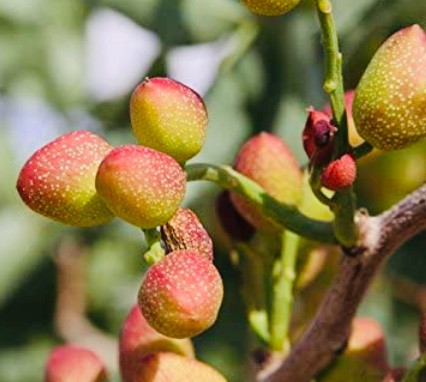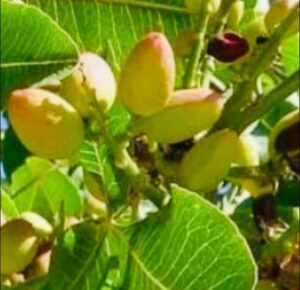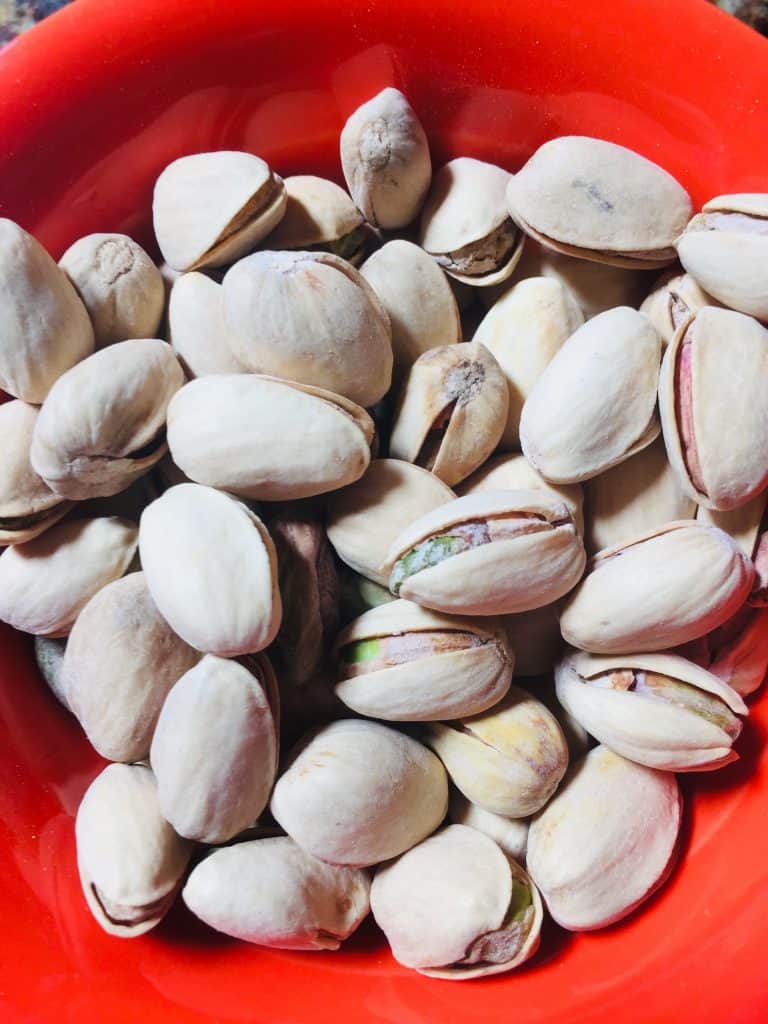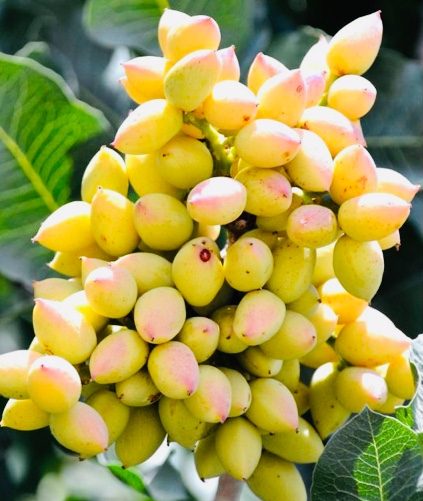Learn about growing a pistachio tree and how pistachios grow. You’ll need a male and a female tree to produce nuts.
Achieving successful harvests requires patience. With the right climate, your backyard might be the ideal spot.
Pistachio Tree
Knowing where to grow a pistachio tree is critical in order for it to live and thrive.
Climate is the most critical prerequisite to success in growing pistachio nuts as Pistacia vera needs exactly the right conditions to flourish.
What’s more, pistachios have the strictest environmental requirements of any nut crop that’s commercially grown. The most vital climate factors are:
- Temperature
- Rainfall and Humidity
- Hardiness zone
Temperature
They love hot, dry, and long summers. As such, pistachio trees do best when temperatures reach 100 F during the day, but they also require cold winters to enter their dormant period.
However, winter must not be too cold. The ground cannot freeze, and the tree needs to spend around 1,000 hours at or below 45 F for dormancy. They are considered to have a high chilling requirement.
Rainfall and Humidity
Additionally, pistachio trees don’t do well in areas of high humidity, and they need good drainage to survive. Frequent rainfall can lower the quality of the fruit, so it’s best that the area does not receive excessive rainfall.
Hardiness
Pistachio nuts are typically grown in hardiness zones from 8 to 10 in the USA. They are hardy to 10 degrees F.
When coupled with the critical climate factors needed for survival, this limits possible growing regions to Arizona, New Mexico, and Southern California. Most of this area is dry desert with limited rainfall.
Male-to-Female Tree Ratio
Pistacia vera is dioecious which means it does not self-pollinate. This means you need to plant more than one pistachio tree.
In addition, you’ll need to plant a male pistachio tree which will have male flowers and a female pistachio tree which will have female flowers. The female flower is apetalous (it doesn’t have petals).
You’ll need both male and female trees to produce nuts.
An example of a male variety is Peters. It pairs well with Kerman. Typically, Peters’ initial spring bloom coincides (and is slightly ahead of) Kerman variety. Only the female pistachio trees will produce pistachios.
Pollination occurs with the wind. The wind carries the pollen from the male flowers to the female flowers.
To maximize wind pollinating, you have to plant them strategically. Ideally, there should be one male tree for every 7 – 9 female trees, with the male in between the females.
You can also plant just two, a male and a female pistachio tree. Once established, female trees will produce every other year.

How to Grow a Pistachio Tree
They are deciduous trees. If you’ve determined that your climate is right for pistachio tree growing and you have the space for two or more trees, use these steps to get started.
Plant Pistachio Saplings
If you live in climate zones 8, 9, or 10, you may be able to go to a nursery or garden center in your area to purchase cuttings or grafted saplings that are ready for planting.
To graft trees from an existing pistachio tree, be sure it’s a minimum of 31 inches up from the ground.
You can also find them online although growers aren’t always able to ship them to every state. They often sell them with a male variety and female variety together.
Buying an established plant will is ideal because it already takes years for the trees to bear fruit.
Plant from Seed
Some people prefer to buy raw pistachio seeds to germinate. If you choose this route, buying from a nursery is best. Since it’s impossible to know the sex until it’s time for your tree to bear fruit, you’ll have to plant multiple trees to ensure you have enough males and females.
Again, bear in mind the germination process adds time to an already-long process.
Planting
Whether you buy a sapling or germinate seeds, you will need to plant them when they are a year old. Planting should take place between January to March and is relatively straightforward.
- Make sure the holes are as deep as the root ball and twice as wide.
- When you place the plant in the hole, it must be as vertical as possible.
- Use your fingers to lightly pull the roots off the ball and into the soil.
- Use all the soil from the container and mix in native soil.
- Water the soil as you put it back in the hole, which will prevent air pockets from occurring.
Before filling the hole with soil, make sure to pick out any stones, weeds, or plants, as these remains can prevent growth.
Tree Spacing
To be successful with your orchard, you need to plant a minimum of two trees; however, it’s better to have several female trees for each male.
They need their space. Ensuring there is adequate space between them is critical to their success. Space them a minimum of 12 feet apart.
Pistachio trees can grow to 30 feet tall.
Proper spacing is also critical to ensure pollination between male and female trees. Too much spacing can prevent pollination from occurring. You should plant your female trees within fifty feet of a male to avoid problems with pollination.
How to Care for Pistachio Trees
After planting, what should you do next to ensure its survival? The good news is they are relatively low-maintenance once they are established.
Watering
Remember, they are dry-weather loving trees. They are drought tolerant.
Because pistachio trees are native to arid regions, watering is less critical than with other species. For the first couple of years, water the tree once per week with a deep soak. Be careful to pay attention to the soil moisture so as to not encourage mold growth.
But after the tree establishes, you may want to forego weekly waterings. Instead, deep watering every month is the best way to irrigate.
When you do water, the soil should be moist up to four feet deep.
However, if in a given month your area has received plenty of rain, you can skip watering altogether. You can also skip watering in the winter months when your tree is dormant.
Once the fruit sets, stop watering.
Beginning in October, you can stop watering, which helps the tree prepare for the cold months.
Sunlight
Because of their love of heat, you may have guessed that pistachio trees also love sunlight. Pistachio trees need full sunlight to prosper and take full advantage of the hot, arid climate it prefers.
Soil
Pistachio trees are hardy, and they can technically grow in just about any soil type, though some are better than others. For example, you should avoid wet and heavy soils.
Choose light and sandy loamy soils with a pH between 7.1 and 7.9. Well-draining soil is a must.
Fertilizer
Pistachio trees need to be fertilized once each spring, starting in the second year. You can add 10-10-10 NPK fertilizer.
You may want to do a soil test before doing so. A soil test can help you determine what nutrients it’s lacking and optimize the fertilizer accordingly. Nut trees require nitrogen to thrive.
Pollination
Pollination in the pistachio tree occurs thanks to the wind, which disperses pollen from male trees to the flowers of the female trees. For this reason, areas known for receiving gusty windows are some of the best for achieving a healthy pistachio harvest.
However, be aware that more intense storms may interfere with pollination, which usually occurs sometime from early to mid-April.
Pruning
Pruning is an essential part of caring for any tree, and pistachios are no different. You should do any pruning required in winter, when the tree is dormant, and remove any branches that have died or appear to be dying. Take care to also remove any branches that cross over another.
Otherwise, prune when branches are six feet long.
Try to prune only where strictly necessary. Removing too many branches can be detrimental to nut production. And remember, dormant pruning is key; however, light summer pruning is okay.
Budding
Budding is a technique used to optimize pollination. It involves joining parts from two or more plants and making them appear to grow as one.
Many professional growers benefit from budding combinations of rootstocks and scions. Rootstock, as you might guess, is the bottom part that creates roots. Scion, on the other hand, is responsible for the upper part of the tree and determines fruit characteristics.
Pioneer Gold 1 and UCB-1 are popular rootstalks, and they may help prevent diseases like verticillium wilt.

Harvesting
With proper care, you will be able to enjoy the literal fruits of your labor. Harvesting comes once your pistachio tree begins to bear fruit. There is uniform nut maturity which means the nuts ripen all at the same time.
Harvest Length
Anywhere from 5 – 7 years after planting is when you can expect your first harvest, an event that typically occurs in October. As trees continue to mature, they will produce higher yields.
Pistachio trees bear fruit biennially. This means they produce a small crop one year, followed by a larger crop the following year.
When to Pick Pistachios
You’ll notice two things when your pistachio nuts are ready to harvest.
- Hulls take on a distinct pinkish-yellow color
- The outer husk of the nut, or epicarp, separates from the inner husk
Once you observe these changes, it’s important to harvest the nuts as soon as possible. They become vulnerable to bugs and diseases the longer they stay on the tree.
How to Harvest Pistachios
The great news is they are easy to harvest. Pistachios grow in clusters.
Before harvesting the nuts, put a sheet or tarp underneath the tree. This practice makes it much easier to collect them, which you do by shaking the tree. The nuts will fall easily from the branches.
Afterwards, let them dry in the sun for a few days, making sure to protect them from critters. Discard any that are black, empty, or moldy.
If any shells aren’t cracked open, you’ll need to open them to dry out the nut. They should be a green color.
Taste test them after a few days. If they aren’t firm and crunchy but seem soggy, dry them longer.

Growing Tips
Although pistachio nut trees are low-maintenance, there are some growing tips you should keep in mind.
It’s vital to remove any weed growth around the trees. Weeds can trap moisture around the trunk and lead to fungal disease.
Remove fallen fruit and leaves from the area around the tree, which will help keep pests away.
Overhead irrigation systems are not ideal for pistachio trees. They cause wet foliage and bark, which increases the likelihood of disease.
Some growers prefer to plant seedlings in containers at the start of the tree’s life, where they can stay for 3 – 5 years. However, the long taproot means that long-term container growth is impossible. After this time, it’s vital to transplant them to the garden so they can continue on their journey to maturity.
Start small. You don’t need acres of pistachios for a pistachio crop. A mature pistachio tree will produce up to 50 pounds of nuts. Start with at least two trees. Plant more if you have the budget and enough space.
Signs of Healthy Trees
The leaves of a healthy tree should be green. Yellow leaves may be an indication that the tree is getting too much water.
Blooms typically blossom in March or April.
How Long Does It Take a Pistachio Tree to Reach Maturity?
Lots of patience is necessary when growing pistachio trees. This is because they take a long time to mature. They are not fast-growing trees.
Though nut production may begin around the 5th year after planting, pistachio trees don’t reach full maturity for much longer. The process can take as long as 15 – 20 years. Still, in most cases, you can expect good production after 8 – 10 years.
If you are looking for a fast-producing tree for a food source, consider a mulberry tree.
How Do Pistachios Grow?
Pistachios grow in clusters, much in the same way grapes do. These clusters come from shoots that form the year prior.
How Tall Do Pistachio Trees Get?
Mature trees can reach a height of up to 33 feet (10 m). Most grow to 20 – 30 feet. Their width is 20 feet. They are excellent shade trees for desert dwellers.
Growing Concerns
Unfortunately, the pistachio tree is vulnerable to certain pests and diseases that can negatively affect tree health.
Pistachio Tree Pests
- Navel orangeworm
- Oblique-banded leafroller
- Citrus flat mite
The greatest threat to pistachio trees is the navel orangeworm. Left unchecked, they can reduce your tree’s yield. The presence of this pest also means that sanitation of unharvested nuts is critical.
Other pests to be aware of are the oblique-banded leafroller, a moth pest that feeds on several species of fruit trees, and the citrus flat mite.
Diseases
- Verticillium wilt
- Phytophthora root rot
Pistachio nut trees are also vulnerable to fungal attacks, specifically verticillium wilt. This condition can cause the death of the tree after entering the root, and it has become a concern in pistachio orchards in California.
Phytophthora root rot, a soil-borne fungal disease that attacks the root of the tree, is another worry for farmers.
Blanks and Hollow Pistachios
In addition, to insect damage and diseases, other concerns are loose shells and meats and blanks or hollow pistachios (empty shells).
There are several reasons this could happen.
The male tree may not have pollinated the female.
Another reason could be boron deficiency. One way to tell is to do a soil and leaf tissue analysis. According to the University of California Cooperative Extension Office, boron leaf levels need to be a minimum of 120 ppm.
While the trees are drought tolerant, if they didn’t receive enough water before the high heat, they can experience heat stress which can cause the fruits to not set.
Pistachio Varieties
According to New Mexico State University, there are many species of pistachio trees.
Pistachios have been cultivated for a long time, beginning thousands of years ago in the Middle East and Central Asia. Over time, there have come to be several varieties, some of which include:
- Bronte
- Chico
- Golden Hills
- Joley
- Kaz
- Kerman
- Lassen
- Peters
- Pioneer Gold
- Platinum
- Randy
- Red Aleppo
Examples of male varieties: Peters, Chico, Kaz, Randy
Female pistachio varieties: Kerman, Red Aleppo, Joley, Kalehghouchi, Ibrahmim, Lassen, Ohadi, Safeed, Shasti, Trabonella, Bronte
Kerman and Peters are the ones backyard growers and commercial operations in California tend to favor. In addition, Randy and Golden Hills work well together.
Growers will be able to help you pair a male with female trees. The goal is to have a good harvest with clean, edible split nuts (instead of closed shells).
Note, the Chinese Pistache is an ornamental tree and doesn’t produce nuts.
Other Important Info
Here is important info about pistachio trees.
Pistachios are Drupes
Though the culinary world treats them as such, it’s important to recognize that pistachios are not technically nuts. True botanical nuts, such as chestnuts, hazelnuts, and acorns, are characterized by a hard inedible shell and seed that does not open on its own to release the seed.
Pistachios, on the other hand, are the edible seed of the pistachio tree fruit. They are known as drupes, which are fleshy fruits that surround a stone or a pit with a seed.
Other examples of drupes include cashews, pecans, almonds, and coconut.
Pistachio Trees are Unisex
Trees can only have either male or male flowers, with male trees capable of fertilizing up to ten females. For this reason, this ratio is the one most commonly seen in orchards.
Pistachio Tree Yield
Pistachio tree yield depends on how old the tree is.
In its fourth or fifth year of life, one tree will produce around 2.2 to 4.4 lbs of dry nuts. By the time it’s seven to ten years old, production increases to 13 to 22 pounds dry nuts per tree.
At full maturity, a pistachio tree is capable of producing up to 50 lbs of pistachios per tree.
Final Thoughts
For many, the pistachio is the king of healthy snack foods. It’s rich in nutrients, dietary fiber, and protein, while at the same time low in calories and saturated fat.
With all the health benefits, pistachio enthusiasts may want to grow them in a backyard orchard.
They store well. Plus, who doesn’t love munching on a delicious handful of pistachios?
Though it will be many years before you can enjoy them, they are well worth the wait. If you live in the right climate with a long dry and hot summer, planting pistachio trees is an excellent way to take advantage of this wonderful food.
Hazelnut Tree Growing Requirements, Maintenance, and More

